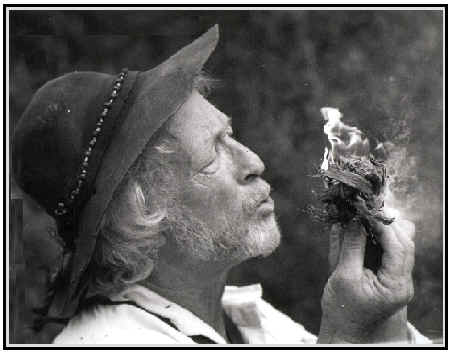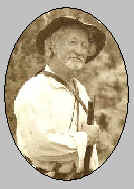WHERE
DID THEY GO?
Because most
organizations and clubs interested in the American
fur trade, and the mountain men who were part of
it, date their involvements from about 1820 to
1840, they seem to ignore what happened to the
trade and the men afterward. Neither the trade nor
the men ended with the decline of the market for
beaver. The fur trade merely shifted to the pelts
of other animals (consider the market in buffalo
hides) and continues to this day. The mountain men
and trappers continued living and either went on
to more civilized pursuits or remained in the
inter-mountain west trapping, guiding and/or
working as interpreters for various organizations,
or otherwise providing for themselves.
It is pretty
well known where the trappers whose names have
remained in our consciousness, names like Bridger,
Meek, Fitzgerald, Sublett, Carson and so on, ended
up. But there were a plentitude of mountain men
whose names are no longer remembered but who were
important to the business. They too had hair
raising adventures and were an important part of
the history of the times. Men like Marcelino Baca,
James Baird,, John Burroughs, Richard Campbell,
Joseph Dickson and the still remembered, although
not so well, James Baker, and many others who had
their moments in the sun. And they too had
productive and interesting lives after 1840.
Many people
know that on Lewis and Clark’s return voyage,
John Colter asked for and received permission to
leave the expedition and go back up river to trap
with two free trappers they’d met who were
headed for choice beaver country, wherever that
might turn out to be. Those two men were Joseph
Dickson and his partner, Forest Hancock. Neither
of the pair knew anything of the country ahead of
them but Colter did. It seemed like a win - win,
but taking him on proved to be a poor decision for
Dickson, experienced trapper though he was.
Dickson had
embarked on the trip to trap enough prime (winter)
furs to finance the purchase of land on which to
build a home for the family he’d left behind. He
and Hancock had spent a few weeks hacking a
pirogue out of a huge cottonwood tree. Finished
with their preparations, they paddled upstream
past where Sergeant Floyd was buried. They dug a
cave in the sunny side of a hill and prepared to
face their first winter in the wilderness. Over
the next two years, each time they had an
appreciable amount of furs the packs were stolen
or taken by unfriendly Indians. In time, they got
past them and near the mouth of the Yellowstone
River they met, first, Captain Clark and the next
day, Captain Lewis, who, up to that moment,
hadn’t known whether he was ahead or behind
Clark. Shortly after they made their arrangement
with Colter and made for virgin beaver streams. It
is probable that the place they decided to winter
and trap was Clark’s Fork Canyon. Shortly after
they arrived Colter had a disagreement with
Dickson and persuaded Hancock to leave with him.
They deserted Dickson, leaving him, however, with
most of the supplies.
That winter,
(1806 - 1807), was a real monster, long and with
heavy snows, perhaps six to eight feet on the
flats. Dickson’s trapping required that he be
daily exposed to long walks in bright sunlit snow.
Ultimately, he became snow blind.
He had never
been particularly religious but now he knelt and
prayed. He promised God that if he would just get
him out of this mess he’d be a devout Christian
the rest of his life. When his prayer was finished
he was left with the strong impression that he
should take and use the inner bark from a tree
that stood just outside the cave in which he was
camped. This he did, pounding the bark until it
was suitable, soaking it in water, and applying it
to his eyes as a poultice and rinse. Not knowing
whether it was day or night, he lay down and
slept. When he awoke, although imperfect, he could
see. In time his eyes healed completely. He
continued to trap.
In the
spring, he made up two canoes, loaded them with
somewhere between fifteen and twenty packs of
beaver and took off for St. Louis. Along the way
he was attacked by some Indians. One large fellow
waded out and grabbed a canoe while on the bank
another raised his rifle to shoot. Dickson quickly
laid hold of the burly Indian and pulled him near.
The bullet meant for him instead struck and killed
the Indian. While the other Indians stood for a
moment, aghast at what had happened, Dickson made
his escape.
When he
arrived at St. Louis he sold his pelts for several
thousand dollars, this was in July of 1807. He
returned home after an absence of three years.
Shortly after he’d left his wife had borne a
fourth child. Dickson was baptized and joined the
Methodist church. He stayed there in the American
Bottom long enough for his wife to bear five more
children. He decided it was time to move to the
Sangamo country. At the ferry landing at Cahokia,
he took his wagon wheels to the local blacksmith
where they could be tightened. The job was done by
the smithy’s apprentice, a youth named Jim
Bridger. Twenty five years later Bridger
established a business at what is now Fort
Bridger, Wyoming.
In May,
1818, Dickson settled on Horse Creek, next to what
is now Springfield, Illinois. The cabin he built
that summer was the first white man’s cabin in
Sangamon County. There he farmed (mostly wheat)
and trapped. Joseph Dickson kept the promise he
made to God in that awful winter of 1806 - 1807.
He donated five acres of his farm (which he did
not have title to—that would come when the
government made Illinois a state that December)
for a church (it still stands though it has had to
be rebuilt three times)and cemetery. He remained
for the rest of his life an active member. He
promoted and helped pay for a school, became an
election judge, and though a Jeffersonian
Democrat, in 1835 he joined the anti - Jackson
party called Whigs.
Joseph
Dickson died at the home of a daughter in
Franklin, Illinois in 1844. He is buried there.



